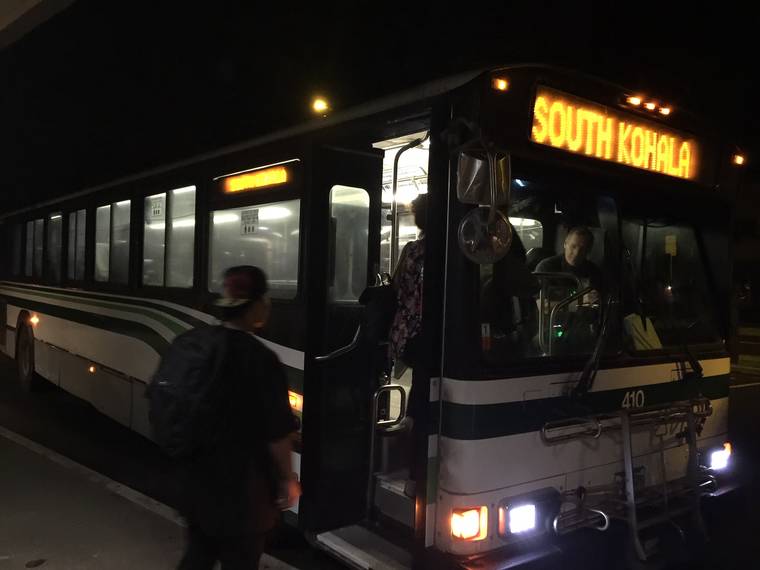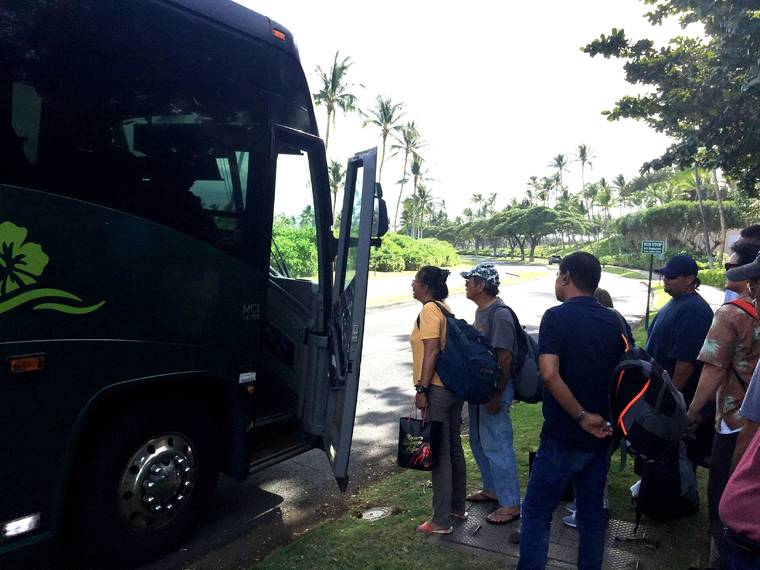Hele-On bus system ‘meltdown’ leaves schoolchildren, working poor stranded

The 5:05 a.m. Friday bus from Hilo to Kohala resorts is a city bus with lots of standing room. (Courtesy photo/Stefan Buchta)

Hilton Waikoloa Resort hotel workers react with dismay when the driver of the 3:30 p.m. Thursday bus to Hilo bus tells them there’s no more room for passengers. (Courtesy photo/Stefan Buchta)
HILO The working poor and schoolchildren are left stranded. Bus schedules are inconsistent and would-be riders waiting at bus stops often dont know when a route has been canceled.
HILO — The working poor and schoolchildren are left stranded. Bus schedules are inconsistent and would-be riders waiting at bus stops often don’t know when a route has been canceled.
Combined routes and smaller buses leave some behind when the bus reaches capacity. Bone-weary hotel workers must stand in the bus aisles for their two-hour trip home after a long day on their feet.
The public bus system may be a convenience for some, but for others it’s a lifeline.
Waiting for the bus has taken on a whole new meaning, as Hawaii County officials try to patch together enough of a fleet from a steadily eroding hodgepodge of county and privately owned buses to hold them until new vehicles currently on order reach Hawaii’s shores.
Four new buses are scheduled to arrive at the end of February. A grant announced in November will purchase another 10 buses.
After a week of even fewer buses than usual, Mayor Harry Kim on Friday called an emergency meeting and together, top officials came up with an interim plan that will draw on buses and vans from the public and private sector, in addition to those of current bus contractors Roberts Hawaii and Polynesian Adventure Tours Inc.
Buses that were yanked from their routes because they’re not compliant with the Americans with Disabilities Act will be returned to the road, with disability vans on call to pick up, within 30 minutes, passengers who need them.
“We all have to understand how critical this is — can you imagine all the people waiting to catch the bus and we give them this last minute announcement?” Kim said. “No work, no pay. We are addressing this issue. It’s so critical.”
It can’t happen soon enough for riders.
“They canceled the Pahoa 3 bus that picks up students from Nawahi. A school that doesn’t have school buses,” a working mom posted Jan. 7 to the Facebook Hele-On users group page. “Some of us parents rely on that bus to get the kids to town cause we work and my kids walk to my job from there. … Kids were left at school. What’s sad is we have to now wait for a call from the kids to let us parents know if the bus got them or not. What a way to start 2020.”
“Meanwhile people lose their jobs who rely on the system,” said another person posting.
“Someone was asleep at the switch and failed to take advantage of grants and other opportunities to get the proper equipment,” said another poster. “It seems like they were trying to take the easy and cheap way out of truly running a system and are now leaving their passengers stranded on a regular basis.”
West Hawaii Today reached out to a number of those posting in the group and is not using their names without permission.
Trouble in the county Mass Transit Agency is certainly nothing new. But a cascade of problems put off over the past 10 years has reached critical mass, leaving Mass Transit Administrator Brenda Carreira — and county taxpayers — holding the bag.
Frequent Hele-On rider Stefan Buchta calls it a “meltdown.” He’s been making regular trips to Kohala from his Keaukaha home. Here’s his recent experience:
“As of 4 p.m. (Thursday), 40 workers from Hilton Waikoloa Resort, many tired, were waiting in front of the hotel for their return bus home to Hilo. The 3:30 p.m. connection (served by Roberts Hawaii) had been on time, but the bus was full to the last seat after stopping first at Marriott Hotel and picking up workers there. The Roberts driver opened the door to inform us, but he did not let anybody on. A few were able to organize a ride home amongst themselves. The rest, exasperated, settled in for a longer wait. By 4:15 p.m., the waiting crowd was now at over 50 people. The next bus, scheduled 4:05, was cancelled. The 4:20 bus came and it took 30 of the 50 waiting people. The rest of the workers finally left on the 4:30 run, after waiting for two hours.”
Buchta said no one blames the current administrator; in fact bus drivers and employees alike praise her efforts and her attitude.
“I don’t think anybody’s blaming her. It just seems that everything came to a head in the last week or so,” Buchta said. “On the positive side, communication has improved in major ways since Brenda took over. For the first time, the Mass Transit website is now consistently updated every day and lists all planned cancellations and service changes.”
Carreira, the third administrator in less than a year, took over Oct. 1, 2018. She inherited an agency plagued by inconsistent bus schedules, broken buses, a drop in ridership, an audit that blasted sloppy cash-handling practices and low employee morale. Despite the availability of federal grants that would have provided buses while costing the county nothing, there were no grant applications or purchases from 2014 until she was hired.
“I advised them of many grants that could have been pursued, however, I was told we lacked the resources to apply,” said John Andoh, who worked as a county transportation specialist in 2014 and 2015 and is now executive director of the regional transit authority in Columbia, South Carolina. “This is very troubling and sad and I feel the pain of the riders every time I am on island.”
Kim and the County Council added first a one-quarter cent and then another one-quarter cent local general excise tax surcharge on each $1 in purchases to pay for buses and road improvements. That’s an additional $50 million in a $425 million annual county budget. But changes are coming slowly.
Carreira continues to apologize for a problem that’s largely outside her control.
And constituents continue calling their County Council representatives to complain.
“We’re slipping. We put money towards it. We invested time, energy and money. At what point are we going to say, you know what, we invested time, money and energy and we have to rethink the process,” Hilo Councilwoman Sue Lee Loy, chairwoman of the Public Works and Mass Transit Committee, said at a hearing last week. “At what point is enough, enough? Because it’s the public’s money, right? And we’re not just going to keep throwing money at that.”
South Kona/Ka‘u Councilwoman Maile David said she was getting calls and text messages last weekend from constituents trying to catch the bus and she was at a loss on how to help them.
“If I’m catching the bus and I need to get to work, I won’t know until I’m actually standing on the road, and then I find out the bus is not coming. I don’t know, how long do you wait? And for rural areas, this is a serious problem,” David said. “I think that’s a really serious problem that we’re facing right now because people depend on that. I think the bus is just so urgent.”


